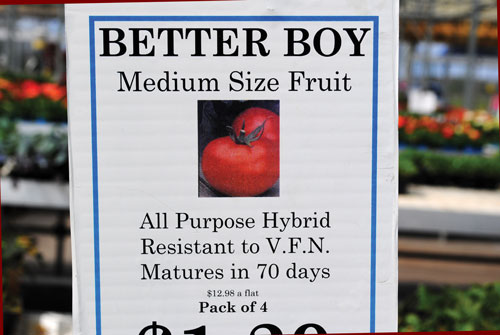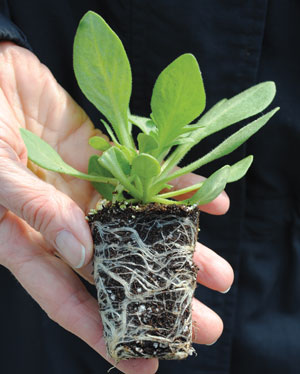
Bulletin E3175
Michigan Fresh: Healthy Garden Transplants Pay Big Dividends
DOWNLOAD
January 26, 2015 - Mary Wilson
Healthy Garden Transplants Pay Big Dividends
Selecting healthy transplants ensures a great start to a productive and attractive garden. Using the best transplants generally provides reliable plant establishment, reduces pest problems and decreases the time until you reap a bountiful garden harvest.
Purchase plants from a reputable source.
Buy your plants from an established greenhouse grower or garden center. It’s generally a safe bet that a company that has been doing business for many years has managed to stay in business for so long by providing a quality product.
Select disease-resistant plants.
Many varieties of vegetable and ornamental plants are resistant but not immune to certain diseases. If you know which diseases you usually get in your garden, look for a variety with resistance to one or more of those diseases. If you aren’t sure which diseases you have or you are starting a garden for the first time, try a variety with resistance to multiple diseases. This is the easiest and most important way to decrease disease problems in your garden.
Resistant varieties are noted by a letter code (sometimes a series of letters) on the plant tag in the pot or cell pack. For example, “VF” means that the variety is resistant to Verticillium and Fusarium wilts. (Both are hard-to-control diseases. Varietal resistance provides the best means of disease management.) “PM” means that the variety is resistant to or tolerant of powdery mildew. The chart below lists some most commonly used codes.
| Code | Resistant to or tolerant of: |
| A | Alternaria (Alternaria stem cankers) |
| BLS | Bacterial leaf spot |
| BMV | Bean mosaic virus |
| CMV | Cucumber mosaic virus |
| DM | Downy mildew |
| F | Fusarium wilt |
| FF or F2 | Fusarium wilt (races 1 & 2) |
| LB | Late blight |
| N | Nematodes |
| PM | Powdery mildew |
| St | Stemphylium (gray leaf spot) |
| T or TMV | Tobacco mosaic virus |
| TSWV | Tomato spotted wilt virus |
| V | Verticillium wilt |
Inspect plants for signs of insects, diseases or poor care.
Closely examine plants and select sturdy, stout plants with deep green or appropriately colored leaves. Avoid plants with leaves that are dropping, wilted, curled or spotted, or that have holes or brown leaf edges. Be sure to check the underside as well as the top side of the leaves. Also, lightly brush over the plants with your hands. If a cloud of white, fly-like insects appears, do not purchase the plants.
Also, check the stems for lesions or discoloration that indicates the presence of a disease.
Pull a few transplants from their containers and inspect the root system. Avoid those that have a tangle of roots encircling the root ball. These pot-bound plants are especially prevalent late in the season. Also make sure that the roots are white and fibrous -- avoid plants with brown or black roots.
Remove flowers.
Your new transplants will benefit from having their flowers removed at planting. Young transplants without flowers will adjust to their move from the pot to the garden more readily than those in full bloom. Flowering transplants expend their energy on flowering and forming seeds instead of developing the roots needed to support good plant growth and yield.
To help flowering plants adjust, simply remove the flowers when you plant them into the garden. It may be difficult to remove the beautiful flowers you’ve waited all winter for, but a little sacrifice now will increase flowering (and fruiting) throughout the season.
More information
Prepared by: Mary Wilson, MSU Extension educator



 Print
Print Email
Email




